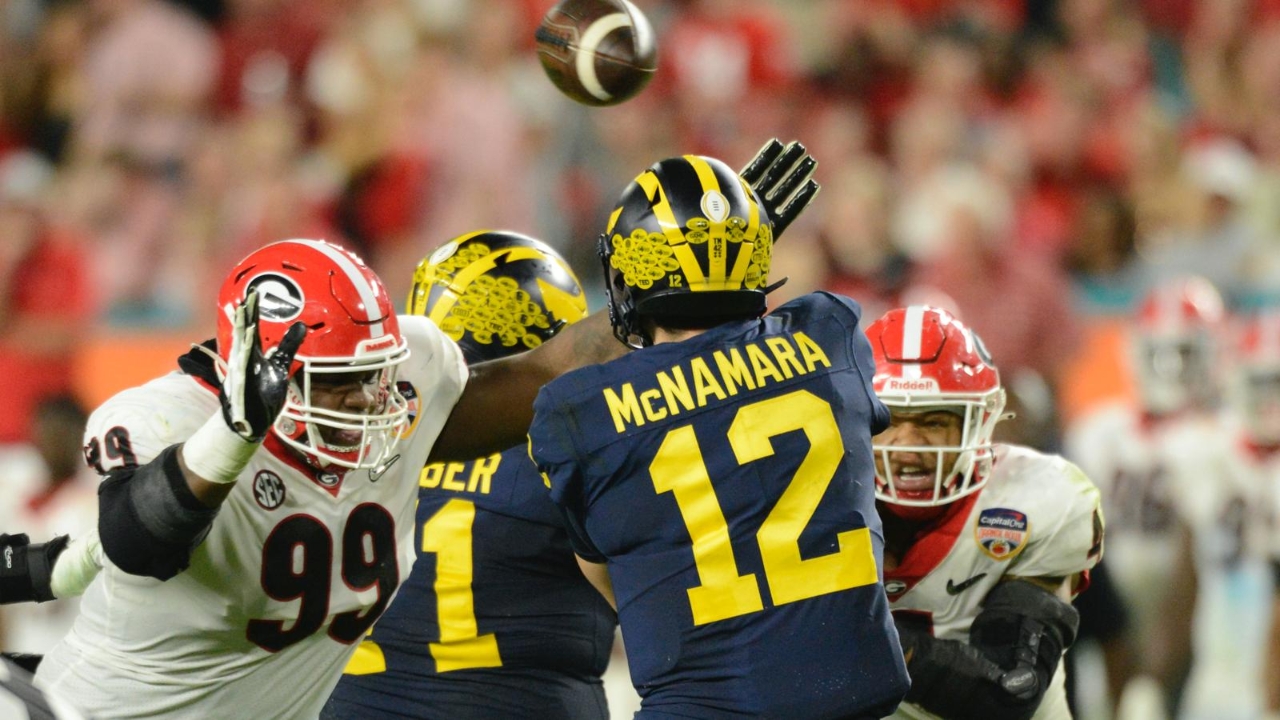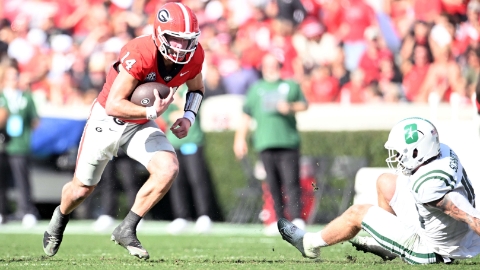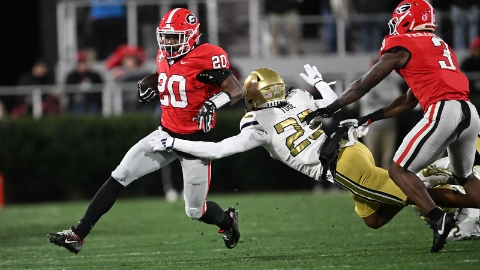UGA Football Braces for the New $20 Million a Year Future of College Football

ATHENS - The end of this decade could be another Big Bang for collegiate athletics - perhaps the final one. The future of college sports, which has been slowly getting here since Georgia and Oklahoma sued the NCAA in 1984 over TV rights, will culminate with massive, substantial and perhaps lasting change in a matter of a few years.
UGA is already scrambling to gather nearly $20 million in payments for players. Those payments are set to start this summer. Georgia has moved personnel inside the athletic association to deal with the fallout of NIL. That comes on the heels of the SEC and Big Ten’s meeting in New Orleans last week. The meeting was another step towards a future where college sports is controlled by those two huge brands.
According to reporting from Yahoo!, the two leagues met to finalize the future of the College Football Playoff. The CFP is now all but under their control, but the two also met to iron out what the future will look like not just in the CFP, but also talked about the possibility of a nine-game SEC football schedule, a scheduling partnership between the two leagues, eight automatic bids for an expanded CFP and “perhaps” even what will happen when the Big 12 and ACC crumble (that’s a less-likely formal discussion right now).
The meeting in the Big Easy is just a setting of the table of sorts - the two biggest, most consequential leagues in the sport controlling their own future as they never have before. Those 34 schools, which have been locked in a cold war for at least this century, appear to be headed to a truce of sorts - unthawing their relationship to they are in position to carve up college athletics for the rest of the 21st century.
In the meantime, there are financial realities that loom over college football like never before. Thanks to landmark cases, players are on the precipice of being paid by schools themselves - something that has never happened on this scale in the history of college sports. This summer will end the decades-long tradition (if that’s what it can be called) of not paying players. It remains to be seen if schools will continue to get away with not classifying paid players as formal employees. That is a major issue.
The class-action lawsuits allowing player payment from schools, best known as House v. NCAA, have set the table for schools to pay “up to 22% of the average Autonomy 5 athletic media, ticket, and sponsorship revenue.” Those smattering of lawsuits appear on the way to being finalized, but have not been yet. Failure to conclude those legal matters would continue fallout and almost certainly keep the now power-four ADs up at night.
All stakeholders - at the conference level, institution level and rights holders - all want clarity on the House decision. At a minimum, schools at least don’t want uncertainty - a feature of college sports that permeated campuses and conference offices this decade.
Last Monday, UGA made a position change for one of its executive staff members. That staff member, Steven Drummond, will now “be responsible for developing and managing partnerships with brands, donors, and NIL platforms to create opportunities for student-athletes.” In other words, he will be the traffic cop between brands and players. Players are not only now paid by the schools themselves, but the schools have a vested interest in the NIL game outside of UGA’s doors. The more money for the players - particularly not money “from” UGA itself - the better.
It is a marked change for Georgia… and the rest of the sport.
Two other big changes to watch from the Big Ten-SEC meeting is an expanded College Football Playoff (which the SEC and Big Ten will now rule in more ways than one) and additional revenue from new media contracts for football games.
Speaking of media contracts, the Big Ten’s and Big 12’s both expire before the 2031 football season. The Big Ten will once more go to the market with all of its properties up for bid. The Big 12 will be in the same situation. It is the year to watch for the destruction, once and for all, of the ACC, and perhaps a permanent realignment in college sports that leaves us with two major conferences - the Big Ten and the SEC.
By 2030, ACC schools like Clemson and Florida State, who have already sued the league, could feel like it would be financially manageable at that point to A) pay their way out of the ACC; B) negotiate an exit from the confernce the way Texas and Oklahoma did with the Big 12 for the 2024 season.
2031’s Very Possible Explosion
By the end of this decade the ACC - even with its deal with Disney in place through the 2025 football season - could push the button to blow itself up. Why?
Money.
Both the ACC and Big 12 (and Notre Dame) are watching as their power in the TV marketplace fades over time. If a significant number of programs from the ACC, in particular, want to blow up the league all at once they can.
It would be an easy move for the likes of Clemson, Florida State and North Carolina (and even Notre Dame). Easy, that is, if they have a landing spot somewhere outside of the ACC. That might continue to be easier said than done.
What is important here is the timing of all of the media contracts for college football. First, the College Football Playoff’s contract expires after the 2030 football season, or 2031 playoff. Most critical? The contracts of the Big Ten (2029 football season) and Big 12 (2030 football season) both expire within a year of one another.
The Big Ten’s situation is a little trickier than the Big 12’s, but it is also the one that is most likely to explode college football. Here’s why: by 2029 college football will have years of an expanded CFP under its belt; the ACC will only have about half a decade of contract left with Disney, so if the league wanted to blow itself up the turn of the decade would be an easy time to do so. ACC insiders have indicated to Dawg Post repeatedly that is the time to watch for the ACC actually going under - or at least watch the exodus of its biggest brands..
The ACC (2035 football season) and SEC (2033 football season) both have deals that go beyond the other college football contracts in terms of years. But unlike happenings in the SEC, ACC members have been suing the conference (Clemson and FSU), and doing due diligence behind the scenes (UNC) to leave. Keep in mind that FSU has written in legal filings that it will exit the ACC, so there’s not much conjecture that about the Noles leaving - they certainly intend to as soon as they can.
The ACC can take a vote to dissolve the conference, or power brokers in the league - UNC, FSU, Clemson and Notre Dame - can just wait out the penalty to leave like USC, Texas, Oklahoma and UCLA did in the early 2020s. That would involve some negotiation as the ACC controls the rights to all home sporting events at ACC schools. UCLA and USC didn’t have to deal with that sort of negotiation. Texas and Oklahoma did.
The Big Ten could use its move into a new TV contract as a way to attract more revenue for members, or the Big 12 could be a better landing spot for the likes of Clemson and Florida State. Either way, it seems likely ACC will see drastic change in the next half decade.
It should be pointed out that leagues won’t just add members to add members. It will have to make fiancial sense.
The challenge will be marrying ACC schools to the right situations for each of them. The SEC has made clear on background to Dawg Post that it is apprehensive about adding the likes of Florida State and Clemson because of a perceived lack of revenue from cable subscriptions to offset the massive payout from media contracts.
North Carolina, Notre Dame and Virginia would almost certainly add value in the form of cable customers paying a so-called in-market rate on subscriptions to the SEC Network rather than an out-of-market rate. Cable subscribers in Virginia and North Carolina that get the SECN pay about a dollar a month fewer than they would if UVA or UNC were in the SEC.
That’s one reason why the SEC would be interested in adding those brands as well as the cable subscription revenue from them. At some stage, however, there could be a tipping point (for lack of a better term), or a market correction for payments from media companies to universities (it is also possible that the athletic department of schools are no longer considered non-profit in the future - another problem that’s been looming as well).
So there are perils ahead for many stakeholders in college football.
$20,000,000 Liability
Class-action lawsuits have all but taken the feet out from under the NCAA and its members in terms of no longer paying players. Those suits, known by most in the industry as “House” (House v. NCAA), have paved the way to finality for at least one major challenge for college sports over the last few years - Payment to players.
Can athletes be paid? How much should they be paid? What about payments to players like Todd Gurley, who were not able to take advantage of NIL deals in the past, but were still used in videos games, etc.? How much will they be compensated for use of their NIL?
All of that is wrapped up in litigation that is expected to be settled before the next fiscal year (late spring 2025). That settlement would set up terms where, moving forward, institutions would pay all student-athletes money to play a sport.
Each school will have to manage the way in which they pay out funds, but they will have to pay out a particular percentage of athletic department budgets each year to players. Where does that money come from? Media, ticket and sponsorship deals. For the first time ever schools will have a line item in their multi-million dollar budgets to pay players - something schools have been fighting since college football began.
Many of us are old enough to remember the lectures and finger waving from administratiors about “too many games” in a college season. Ohio Sate played 16 gmes last year. They would have played 17 had they qualified for a conference championship game.
Georgia is aware of the predicament they find themselves in.
Read the rest of this premium story here:
UGA Football Braces for the New $20 Million a Year Future of College Football


